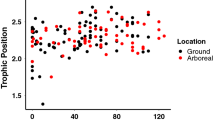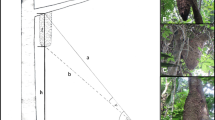Abstract
Resource-ratio theory predicts that consumers should achieve optimal ratios of complementary nutrients. Accordingly, different trophic groups are expected to vary in their N-limitation depending on the extent to which they feed primarily on carbohydrate (CHO) or protein. Among arboreal ants, N-limitation ranges from high (for trophobiont tenders), intermediate (leaf foragers) and low (predators). We report results from a manipulative field experiment in a Brazilian savanna that tests the differential attractiveness of nitrogen and CHO to arboreal ants, as well as experimentally examines changes in broader ant foraging patterns in response to protein and CHO supplementation. Every tree within 32 20 × 20 m plots were supplemented with either protein, CHO; protein + CHO or a water control (n = 8 in each case) for a 7-day period in each of the wet and dry seasons. As predicted, different trophic groups responded differentially to supplementation treatment according to the extent of their N-limitation. The richness and abundance of the most N-limited group (trophobiont tenders) was highest at protein supplements, whereas less N-limited trophic groups showed highest species richness (leaf foragers) or abundance (predators) at CHO supplements. Protein supplementation markedly increased the general foraging abundance of trophobiont tenders, but decreased the abundance of leaf foragers. We attribute the latter to increased competition from behaviorally dominant trophobiont tenders. Our study provides experimental evidence that nutrient availability is a major factor influencing arboreal ant communities, both directly through the provision of different resources, and indirectly through increased competitive pressure.



Similar content being viewed by others
Data accessibility
All data from the full experiment have been deposited in the Figshare. http://dx.doi.org/10.6084/m9.figshare.5930341 (Ribeiro et al. 2019).
References
Andersen AN (1992) Regulation of “momentary” diversity by dominant species in exceptionally rich ant communities of the Australian seasonal tropics. Am Nat 140:401–420. https://doi.org/10.1086/285419
Anderson MJ (2001) A new method for non-parametric multivariate analysis of variance. Austral Ecol 26:32–46. https://doi.org/10.1111/j.1442-9993.2001.01070.pp.x
Anderson KE, Russell JA, Moreau CS et al (2012) Highly similar microbial communities are shared among related and trophically similar ant species. Mol Ecol 21:2282–2296. https://doi.org/10.1111/j.1365-294X.2011.05464.x
Bates D, Mäechler M, Bolker B, Walker S (2015) Fitting linear mixed-effects models using lme4. J Stat Softw 67:1–48. https://doi.org/10.18637/jss.v067.i01
Blüthgen N, Fiedler K (2004a) Competition for composition: lessons from nectar-feeding ant communities. Ecology 85:1479–1485. https://doi.org/10.1890/03-0430
Blüthgen N, Fiedler K (2004b) Preferences for sugars and amino acids and their conditionality in a diverse nectar-feeding ant community. J Anim Ecol 73:155–166. https://doi.org/10.1111/j.1365-2656.2004.00789.x
Blüthgen N, Verhaagh M, Goitía W et al (2000) How plants shape the ant community in the Amazonian rainforest canopy: the key role of extrafloral nectaries and homopteran honeydew. Oecologia 125:229–240. https://doi.org/10.1007/s004420000449
Blüthgen N, Gebauer G, Fiedler K (2003) Disentangling a rainforest food web using stable isotopes: dietary diversity in a species-rich ant community. Oecologia 137:426–435. https://doi.org/10.1007/s00442-003-1347-8
Blüthgen N, Gottsberger G, Fiedler K (2004) Sugar and amino acid composition of ant-attended nectar and honeydew sources from an Australian rainforest. Austral Ecol 29:418–429. https://doi.org/10.1111/j.1442-9993.2004.01380.x
Bolker BM, Brooks ME, Clark CJ et al (2009) Generalized linear mixed models: a practical guide for ecology and evolution. Trends Ecol Evol 24:127–135. https://doi.org/10.1016/j.tree.2008.10.008
Byk J, Del-Claro K (2010) Nectar- and pollen-gathering Cephalotes ants provide no protection against herbivory: a new manipulative experiment to test ant protective capabilities. Acta Ethol 13:33–38. https://doi.org/10.1007/s10211-010-0071-8
Coutinho LM (1990) Fire in the ecology of the Brazilian cerrado. In: Goldammer JG (ed) Fire in the tropical biota. Ecological studies (analysis and synthesis). Springer, Berlin, pp 82–105. https://doi.org/10.1007/978-3-642-75395-4_6
Crawley MJ (2012) The R book, 2nd edn. Wiley, Chichester
Dáttilo W, Marquitti FMD, Guimarães PR, Izzo TJ (2014) The structure of ant—plant ecological networks: is abundance enough? Ecology 95:475–485. https://doi.org/10.1890/12-1647.1
Davidson DW (1997) The role of resource imbalances in the evolutionary ecology of tropical arboreal ants. Bio J Linn Soc 61:153–181. https://doi.org/10.1111/j.1095-8312.1997.tb01785.x
Davidson DW (2005) Ecological stoichiometry of ants in a New World rain forest. Oecologia 142:221–231. https://doi.org/10.1007/s00442-004-1722-0
Davidson DW, Cook SC, Snelling RR, Chua TH (2003) Explaining the abundance of ants in lowland tropical rainforest canopies. Science 300:969–973. https://doi.org/10.1126/science.1082074
Davidson DW, Cook SC, Snelling RR (2004) Liquid-feeding performances of ants (Formicidae): ecological and evolutionary implications. Oecologia 139:255–266. https://doi.org/10.1007/s00442-004-1508-4
Dejean A, Corbara B, Orivel J (1999) The arboreal ant mosaic in two Atlantic rain forests. Selbyana 20:133–145
Del-Claro K, Oliveira PS (1999) Ant-Homoptera interactions in a neotropical savanna: the honeydew-producing treehopper, Guayaquila xiphias (Membracidae), and its associated ant fauna on Didymopanax vinosum (Araliaceae). Biotropica 31:135–144. https://doi.org/10.1111/j.1744-7429.1999.tb00124.x
Dufrêne M, Legendre P (1997) Species assemblages and indicator species: the need for a flexible asymmetrical approach. Ecol Monogr 67:345–366. https://doi.org/10.1890/0012-9615(1997)067%5b0345:SAAIST%5d2.0.CO;2
Dussutour A, Simpson SJ (2008) Description of a simple synthetic diet for studying nutritional responses in ants. Insectes Soc 55:329–333. https://doi.org/10.1007/s00040-008-1008-3
Eilmus S, Heil M (2009) Bacterial associates of arboreal ants and their putative functions in an obligate ant-plant mutualism. Appl Environ Microbiol 75:4324–4332. https://doi.org/10.1128/AEM.00455-09
Feldhaar H (2014) Ant nutritional ecology: linking the nutritional niche plasticity on individual and colony-level to community ecology. Curr Opin Insect Sci 5:25–30. https://doi.org/10.1016/j.cois.2014.09.007
Felfili JM, da Silva Júnior MC (1988) Distribuição dos diâmetros numa faixa de cerrado na Fazenda Água Limpa (FAL), em Brasilia-DF. Acta Bot Bras 2:85–105. https://doi.org/10.1590/S0102-33061988000100005
Fry B (2006) Stable isotope ecology. Springer, New York. https://doi.org/10.1007/0-387-33745-8
Galef BG (1991) A contrarian view of the wisdom of the body as it relates to dietary self-selection. Psychol Rev 98:218–223. https://doi.org/10.1037/0033-295X.98.2.218
Grover CD, Kay AD, Monson JA, Marsh TC, Holway DA (2007) Linking nutrition and behavioural dominance: carbohydrate scarcity limits aggression and activity in Argentine ants. Proc Biol Sci 274:2951–2957. https://doi.org/10.1098/rspb.2007.1065
Hu Y, Sanders JG, Łukasik P et al (2018) Herbivorous turtle ants obtain essential nutrients from a conserved nitrogen-recycling gut microbiome. Nat Commun 9:964
Kaspari M, Yanoviak SP (2001) Bait use in tropical litter and canopy ants—evidence of differences in nutrient limitation. Biotropica 33:207–211. https://doi.org/10.1646/0006-3606(2001)033
Kaspari M, Donoso D, Lucas JA, Zumbusch T, Kay AD (2012) Using nutritional ecology to predict community structure: a field test in neotropical ants. Ecosphere 3:1–15. https://doi.org/10.1890/ES12-00136.1
Kay A (2002) Applying optimal foraging theory to assess nutrient availability ratios for ants. Ecology 83:1935–1944
Kay A (2004) The relative availabilities of complementary resources affect the feeding preferences of ant colonies. Behav Ecol 15:63–70. https://doi.org/10.1093/beheco/arg106
Kay AD, Rostampour S, Sterner RW (2006) Ant stoichiometry: elemental homeostasis in stage-structured colonies. Funct Ecol 20:1037–1044. https://doi.org/10.1111/j.1365-2435.2006.01187.x
Koch EBA, Camarota F, Vasconcelos HL (2016) Plant ontogeny as a conditionality factor in the protective effect of ants on a neotropical tree. Biotropica 48:198–205. https://doi.org/10.1111/btp.12264
Longino JT (2003) The Crematogaster (Hymenoptera, Formicidae, Myrmicinae) of Costa Rica. Zootaxa 151:1–150. https://doi.org/10.11646/zootaxa.151.1.1
Madeira JA, Fernandes GW (1999) Reproductive phenology of sympatric taxa of Chamaecrista (Leguminosae) in Serra do Cipó, Brazil. J Trop Ecol 15:463–479. https://doi.org/10.1017/S0266467499000954
Morgan ED, Jungnickel H, Keegans SJ, do Nascimento RR, Billen J, Gobin B, Ito F (2003) Comparative survey of abdominal gland secretions of the ant subfamily Ponerinae. J Chem Ecol 29:95–114. https://doi.org/10.1023/A:1021928630441
Nepi M, Soligo C, Nocentini D et al (2012) Amino acids and protein profile in floral nectar: much more than a simple reward. Flora Morphol Distrib Funct Ecol Plants 207:475–481. https://doi.org/10.1016/j.flora.2012.06.002
Ness JH, Morris WF, Bronstein JL (2009) For ant-protected plants, the best defense is a hungry offense. Ecology 90:2823–2831. https://doi.org/10.1890/08-1580.1
Oksanen J, Blanchet FG, Kindt R et al (2015) Vegan: community ecology package. R package version 2.4-0
Oliveira PS, Freitas AVL (2004) Ant-plant-herbivore interactions in the neotropical cerrado savanna. Naturwissenschaften 91:557–570. https://doi.org/10.1007/s00114-004-0585-x
Parr CL, Sinclair BJ, Andersen AN, Gaston KJ, Chown SL (2005) Constraint and competition in assemblages: a cross-continental and modeling approach for ants. Am Nat 165:481–494. https://doi.org/10.1086/428292
R Development Core Team (2016) R: a language and environment for statistical computing. R Foundation for Statistical Computing, Vienna, Austria. Retrieved from http://www.R-project.org/
Ribeiro LF, Solar RRC, Muscardi DC, Schoereder JH, Andersen AN (2018) Extrafloral nectar as a driver of arboreal ant communities at the site-scale in Brazilian savanna. Austral Ecol 43:672–680. https://doi.org/10.1111/aec.12612
Ribeiro LF, Solar RRC, Sobrinho TG, Muscardi DC, Schoereder JH, Andersen AN (2019) Data from: different trophic groups of arboreal ants show differential responses to resource supplementation in a neotropical savanna. Figshare. https://doi.org/10.6084/m9.figshare.5930341
Rico-Gray V, Oliveira PS (2007) The ecology and evolution of ant–plant interactions. University of Chicago Press, Chicago
Rudolph KP, Palmer TM (2013) Carbohydrate as fuel for foraging, resource defense and colony growth—a long-term experiment with the plant-ant Crematogaster nigriceps. Biotropica 45:620–627. https://doi.org/10.1111/btp.12040
Russell JA, Moreau CS, Goldman-Huertas B, Fujiwara M, Lohman DJ, Pierce NE (2009) Bacterial gut symbionts are tightly linked with the evolution of herbivory in ants. Proc Natl Acad Sci USA 106:21236–21241. https://doi.org/10.1073/pnas.0907926106
Schoereder JH, Sobrinho TG, Madureira MS, Ribas CR, Oliveira PS (2010) The arboreal ant community visiting extrafloral nectaries in the Neotropical cerrado savana. Terr Arthropod Rev 3:3–27. https://doi.org/10.1163/187498310X487785
Simpson SJ, Raubenheimer D (1993) A multi-level analysis of feeding behaviour: the geometry of nutritional decisions. Philos Trans R Soc B Biol Sci 342:381–402. https://doi.org/10.1098/rstb.1993.0166
Simpson SJ, Raubenheimer D (2000) The hungry locust. Adv Study Behav 29:1–44. https://doi.org/10.1016/S0065-3454(08)60102-3
Sterner RW, Elser JJ (2002) Ecological stoichiometry: the biology of elements from molecules to the biosphere. Princeton University Press, Princeton
Tilman D (1982) Resource Competition and Community Structure. Princeton University Press, Princeton
Wheeler DE (1986a) Ectatomma tuberculatum: foraging Biology and Association with Crematogaster (Hymenoptera: Formicidae). Ann Entomol Soc Am 79:300–303. https://doi.org/10.1093/aesa/79.2.300
Wheeler DE (1986b) Polymorphism and division of labor in Azteca chartifex laticeps (Hymenoptera: Formicidae). J Kansas Entomol Soc 59:542–548. https://doi.org/10.2307/25084816
Yanoviak SP, Kaspari M (2000) Community structure and the habitat templet: ants in the tropical forest canopy and litter. Oikos 89:259–266. https://doi.org/10.1034/j.1600-0706.2000.890206.x
Weber MG, Porturas LD, Keeler KH (2015) World list of plants with extrafloral nectaries. Available from URL: https://www.extrafloralnectaries.org. Accessed 30 May 2015
Acknowledgements
We are very grateful for the many students from Universidade Federal de Viçosa and volunteers from Parque Nacional da Serra do Cipó who assisted in the fieldwork, Ana Paula Pereira, Josielle Evaristo, Larissa Freitas and Scarlett Reis for help with laboratory work, Júlio Chaul, Rodrigo de Jesus and Gabriela Camacho for assisting with ant identification. We are also thank the staff of Serra do Cipó National Park for logistical support and accommodation, and ICMBio for the collection permits.
Funding
This study was supported by Conselho Nacional de Desenvolvimento Científico e Tecnológico (CNPq 442205/2014-7), and the authors were supported by grants from CNPq and Coordenação de Aperfeiçoamento de Pessoal de Nível Superior.
Author information
Authors and Affiliations
Contributions
LFR conceived the rationale of the manuscript and the sampling design, with input from all authors. LFR collected the data. RRCS and LFR analyzed and interpreted the data. LFR wrote initial draft of the manuscript and all authors contributed to further manuscript development and gave final approval for publication.
Corresponding author
Additional information
Communicated by Nina Farwig.
Electronic supplementary material
Below is the link to the electronic supplementary material.
Rights and permissions
About this article
Cite this article
Ribeiro, L.F., Solar, R.R.C., Sobrinho, T.G. et al. Different trophic groups of arboreal ants show differential responses to resource supplementation in a neotropical savanna. Oecologia 190, 433–443 (2019). https://doi.org/10.1007/s00442-019-04414-z
Received:
Accepted:
Published:
Issue Date:
DOI: https://doi.org/10.1007/s00442-019-04414-z




